Chapter 1.1 A Time To Believe
Textbook Questions and Answers
Warming Up:
Question 1.
Think, choose and fill up the labels with what a ‘sunrise’ symbolizes.
(jewellery / art / hope / birth / anger / new opportunities / good manners / inspiration/ new achievements / happiness / misery / bright moments / new aims / money / newsurprises)
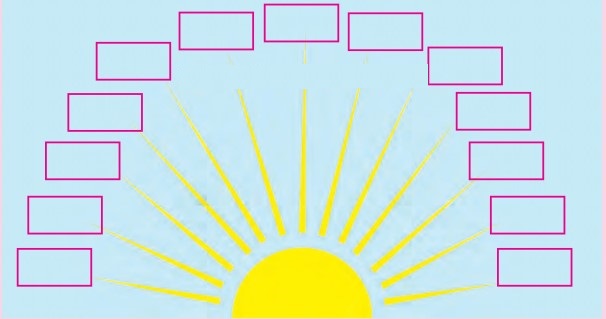
Answer:
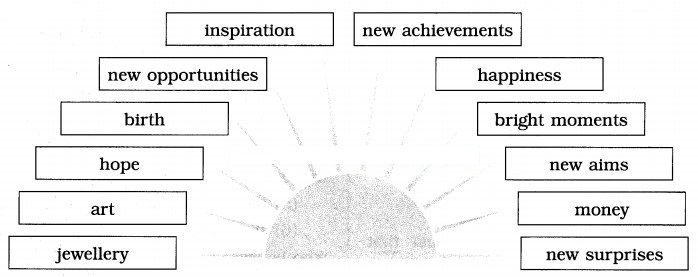
Question 2.
An acrostic is a poem or a write up in which the first letter of each line forms a word, when it is read vertically. Complete the acrostics of BELIEVE and FAITH.
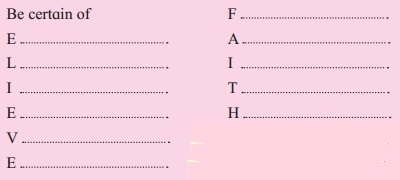
With your benchmate / group, complete the acrostic of BELIEVE and FAITH.
Answer:

1.A. Rearrange the letters to make meaningful words, occurring in the poem.
- clearmis
- sowmid
- tabyue
- madres
- laveu
- downre
Answer:
- miracles
- wisdom
- beauty
- dreams
- value
- wonder
1.B. Write words from the poem that describe the following.
- sky
- heart
- hand
- beginning
Answer:
- stardust sky
- nurturing heart
- aging hand
- new beginning
2. Say WHY. . . . .
Question a.
________ the sky has a magical quality.
Answer:
The sky has a magical quality because it has scurrying clouds, twinkling stars and a beautiful moon.
Question b.
_______ even an aging hand has beauty.
Answer:
because it can teach us how to love.
Question c.
_______we should believe that we are strong and courageous.
Answer:
We should believe that we are | strong and courageous so that we can recover after we have gone through difficulties and shocks, and return to our normal lives again.
3. Make a list of any six things that the poet wants us to accept as true.
Answer:
The poet wants us to accept as j true the following things :
- that we have the strength and ( courage to get back to normal after a setback
- that we are never alone
- that life is a gift we must cherish
- that there are wonderful surprises in store for us
- that all our hopes and dreams are within reach
- that great things will happen if we have belief in life and in ourselves
4. Find from the poem, positive qualities to fill up the web.
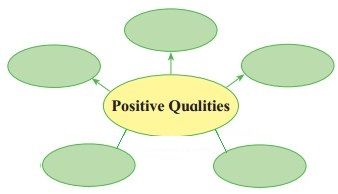
Answer:
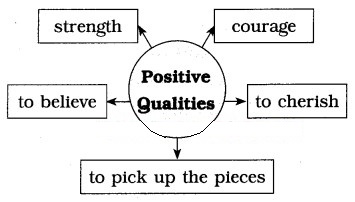
5. Read the lines below.
(A) ‘To believe is to see angels dancing among the clouds’.
The above line contain a human characteristic ‘dancing’ given to something
non – human, ‘angels’. The Figure of Speech used in the line is called
‘Personification’.
(B) ‘To believe is to know that
Everyday is a new beginning’.
(C) To believe is to know ………. life is a gift
Lines in poetry, such as the above, state a general truth and can be used as sayings or
quotes etc. They contain the Figure of Speech called Epigram.
Epigram closely resembles a proverb.
Find from the poem three other examples of Epigram.
Answer:
(i) ‘To believe is to find the strength and courage that lies within us.’
(ii) ‘To believe is to know we are never alone, that life is a gift.’
(iii) ‘To believe is to know that wonderful surprises are just waiting to happen.’
(These lines state a general truth.)
6. Divide the class into 5 groups. Each group can prepare a decorative chart / poster using an epigrammatic lines from the poem. You may use calligraphy / painting / or Paint programme on a computer. (With permission, put up these charts in your school.)
Additional Important Questions and Answers
Complete the following:
Question 1.
One should know and trust _______.
Answer:
One should know and trust that every day is a new beginning, that miracles happen and dreams really do come true.
Question 2.
The two supernatural references in the second stanza _______.
Answer:
The two supernatural references in the second stanza are to angels and to the man in the moon.
Activities based on Poetic Devices/Vocabulary:
Question 1.
Find out an example of Personification from the extract.
Answer:
‘To believe is to see angels dancing among the clouds.’ (Here, the angels have been given the human quality of ‘dancing’.)
Question 2.
Pick out examples of Alliteration from the extract.
Answer:
(i) …. and the wisdom of the man in the moon’. (Repetition of the sound of the letter ‘m’.)
(ii) For it is through their teachings, we learn to love. (Repetition of the sound of the letters ‘t’ and T.)
Question 3.
Pick out an example of Repetition from the extract.
Answer:
The words ‘To believe is to ….’ are repeated at the beginning of each stanza. This provides emphasis to the message in the poem and gives rhythm to the stanzas.
Complete the following:
Question 1.
The two qualities that are needed to recover after a shocking event are _________.
Answer:
strength and courage.
Question 2.
The poet advises everybody to ______.
Answer:
have a positive attitude.
Complex Factual Activities:
Question 1.
Explain why ….
…. we should believe that we are strong and courageous,
Answer:
We should believe that we are strong and courageous so that we can recover after we have gone through difficulties and shocks, and return to our normal lives again.
Activities based on Poetic Devices/Vocabulary :
Question 1.
Rearrange the letters to form meaningful words occurring in the extract.
- gearuoc
- rissupser
- gnehtrts
- irehchs
Answer:
- courage
- surprises
- strength
- cherish
Question 2.
Write word from the extract that describe the following :
surprises
Answer:
wonderful surprises
Question 3.
Pick out an example of Metaphor from the extract.
Answer:
‘That life is a gift.’ Life is implicitly compared to a gift.
Question 4.
Pick out an example of Repetition from the extract.
Answer:
The words ‘To believe is to ….’ are repeated at the beginning of each stanza. This provides emphasis to the message in the poem and gives rhythm to the stanzas.
Question 5.
Analysis/Appreciation Of The Poem ‘A Time To Believe’
Answer:
Poem and poet: ‘A Time to Believe’ by B.J. Morbitzer.
Theme: To believe in ourselves and to have a positive and optimistic attitude towards life.
Tone: Serious and inspirational.
Structure and stanzas: 4 lines in each stanza, except in the last stanza, which has 5 lines.
Rhyme and Rhythm: No rhyme scheme; the poem is written in free verse.
Language and Imagery: The language is simple and direct. The only instances of Imagery are of ‘angels dancing among the clouds’ and the ‘stardust sky’.
Figures of Speech: Personification, Epigram, Repetition, Metaphor.